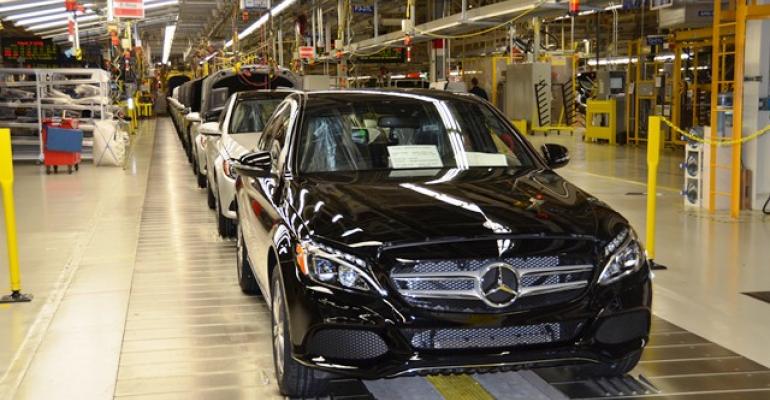BRUSSELS – Automakers are welcoming the new European Union-Vietnam free-trade agreement (FTA) as a key step toward opening Asian emerging markets to imports and investment.
The agreement, agreed in principle Aug. 4, will remove nearly all tariffs on goods traded between the two economies.
According to Cara McLaughlin, a spokesperson for ACEA, the European automakers’ group, Vietnam will eliminate all tariffs in 10 years for small- and medium-engine cars – which currently face 74%-78% tariffs – and in nine years for larger-engine cars (3.0L for gasoline, 2.5L for diesel). Duties on imports of motorcycles with engines larger than 0.15L will be phased out over seven years, according to the Vietnam Chamber of Commerce and Industry.
The agreement “will contain a specific automotive annex with far-reaching provisions to address non-tariff barriers in the automotive sector,” McLaughlin says. “These include, five years after entry into force, the recognition of the EU vehicle whole certificate of conformity, while tariffs on car parts will be completely eliminated in seven years at the latest.”
In comparison, the EU will eliminate its 10% duties on Vietnam vehicle imports, according to the European Commission, the EU’s legislative branch.
ACEA believes “this FTA could provide a positive precedent for negotiations with other ASEAN countries and emerging economies,” McLaughlin says.
Mike Hawes, CEO of the U.K.’s Society of Motor Manufacturers and Traders, agrees the trade deal is “welcome news,” telling WardsAuto: “Asia has recently developed into a major export destination for U.K.-built cars. Economic growth, coupled with increasing demand for high-quality British premium vehicles, has seen exports to the continent triple in the past five years alone.
“With significant recent investment in U.K. automotive manufacturing set to see output reach record levels in the coming years, the industry is looking to capitalize on opportunities in emerging markets.”
Tying Trade Ties Tighter
The EU and Vietnam already have strong trading links. The EU is the fourth-largest importer to the Southeast Asian country and was its No.1 export partner in 2013, according to 2015 data from the EC’s directorate-general for trade. The same data shows that in 2014, the EU imported €44 million’s ($49 million) worth of automotive products while exporting €187 million’s ($208 million) worth to Vietnam.
Vietnam’s young and increasingly affluent population could be a ready market going forward. The country’s auto industry has seen robust growth in domestic sales in recent times. Deliveries jumped 61% year-on-year to 20,349 units in July (a 9% increase on the previous month), according to statistics from the Vietnam Automobile Manufacturers’ Assn.
“This finely balanced agreement will boost trade with one of Asia’s most dynamic economies,” says EU Trade Commissioner Cecilia Malmstrom, who finalized the deal. “It sets a new, better and modern model for FTAs between the EU and developing countries, and establishes a good standard for the trade relationship between the EU and Southeast Asia as a whole.
“Vietnam is a growing economy and once this agreement is up and running, it will provide significant new opportunities for companies on both sides.”
For Peter Cooke, a professor of automotive management at the U.K.’s Buckingham University, this agreement is another step down the road marked globalization. He believes it also should lead to more effective ways to assemble vehicles: “Countries such as Vietnam used to focus on automotive component production. Now they are more interested in automotive subassembly, where vehicles are assembled closer to the end market.”
Cooke suggests the trade pact could damage the relationship between Vietnam and China. In the context of its slowing economy, China might resent the growing trade links between the EU and Vietnam that the agreement reflects.
While a VAMA spokesperson says the Vietnamese industry group is not commenting on the deal, concerns have been raised in local media. Reports have warned the abolition of tariffs under an EU deal and the tariff reduction forecast under the ASEAN agreement on trade in goods, due to take full effect in 2018, could jeopardize the growth of local manufacturing, making it cheaper to import a foreign car than to assemble locally.
Besides Vietname, the ASEAN bloc comprises Malaysia, the Philippines, Singapore, Brunei, Cambodia, Laos, Myanmar and two of Vietnam’s major auto competitors, Thailand and Indonesia.
Officials are drafting a legal text for presentation to the European Parliament, the EU Council of Ministers and Vietnam’s national assembly for ratification, possibly in 2016.
– with Lee Adendorff and Mandy Kovacs




